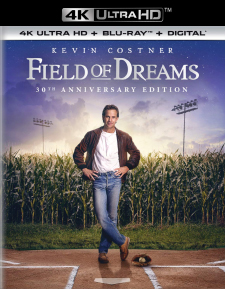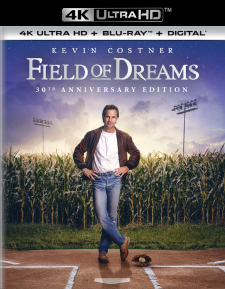Field of Dreams: 30th Anniversary Edition (4K UHD Review)

Director
Phil Alden RobinsonRelease Date(s)
1989 (May 14, 2019)Studio(s)
Gordon Company (Universal Pictures)- Film/Program Grade: A
- Video Grade: A
- Audio Grade: A
- Extras Grade: A-
Review
Some films work because of what they get right, while others work in spite of themselves. Field of Dreams is the rare example of one which does both. As the quintessential expression of the uniquely American love of baseball, it should require audiences to share a love of the sport in order for them to connect with it—except that it really doesn’t. Yes, lifelong baseball fans will find personal meaning to the story, but even those who can’t stand the sport will appreciate what it has to say. This simple tale of a man who hears a voice telling him to build a baseball field on his Iowa farm has obvious layers which relate directly to the sport, but it also has many that dig far deeper.
Personally, I have absolutely no romanticized view of baseball, and all of the talk in the film about the “magic” of the sport is meaningless to me. I don’t have fond childhood memories of going to games, playing catch, or anything else related to baseball. Despite being a native Minnesotan and an automatic supporter of teams from my home state, I never watched a minute of either the 1987 or 1991 World Series. Even today, the thought of watching a game has zero appeal for me. Yet every time that I see Field of Dreams, it manages to completely disarm me. It simply works, full stop.
One reason why is thanks to the unabashed earnestness of the film, and the complete sincerity of its cast and crew. If there was a false note anywhere, it would sink the entire film. As viewers, we believe the fantasy because the actors appear to genuinely believe in it. I have never been much of a fan of Kevin Costner, but I can’t imagine the film succeeding with any other actor as Ray. This story needed Costner acting in maximum Aw Shucks Mode, and he delivers that in spades. Even Amy Madigan manages to take the thankless role of his impossibly supportive wife Annie and make it work. Is her character’s willingness to let Ray build the field plausible? Absolutely not. Does that matter? No, because Madigan sells it so well that we buy it anyway. The rest of the cast performs with equal truthfulness, from major players like James Earl Jones to minor ones like Art LeFleur. Timothy Busfield also plays the obligatory role of the skeptic with the same sincerity as the rest of the true believers.
Writer/director Phil Alden Robinson adapted the book Shoeless Joe by W.P. Kinsella, changing a few key elements such as turning the real J.D. Salinger from the novel into the fictional Terence Mann for the film (necessary since Salinger had objected to being used in the book and threatened litigation if his “character” appeared in any other version of the story). Robinson wisely avoided any traces of ironic detachment which could have derailed the story. His direction is simple, unobtrusive, and it always allows the actors to do the heavy lifting of making audiences believe not just in the return of Shoeless Joe Jackson, but in the mystical power of baseball itself—even convincing skeptical audience members like me. That’s the ultimate in suspension of disbelief; while making people believe in ghosts is one thing, making baseball agnostics believe in its magic is a genuine accomplishment.
Field of Dreams was shot on 35 mm film by cinematographer John Lindley using Panavision cameras and lenses, and framed at 1.85:1 for its theatrical release. The native 4K scan for this Ultra HD version shows an abundance of fine detail and natural-looking grain which is never obtrusive, though it’s mixed with a touch of noise in a few shots. Everything from the textures of the uniforms to the grass and dirt on the ballfield shows much more detail than it ever did before. The HDR grade (HDR10) provides substantial improvement to the contrast range and black levels—check out the deep black sky around the moon at the beginning of Chapter 4, or the bright halation around the lights at the beginning of Chapter 6. At first glance, the color timing appears warmer than on previous versions, but when compared to the Blu-ray, it’s not so much a matter of being warmer as it is of being more consistently warm—the color timing wavers quite a bit on the Blu-ray transfer. This HDR grade may or may not be accurate compared to the original theatrical prints, but it looks gorgeous and it seems entirely appropriate for the idealized nature of the story. For Iowa to become heaven, the grass should be greener and the sky should be a more dazzling shade of blue.
The primary audio option is a new English DTS:X (English 7.1 DTS-HD Master Audio compatible) mix which gently expands the soundstage, but in a way that never takes away from the character of the original Dolby SR mix. The environmental effects are still subtle, though they’re now positioned a bit more precisely around the viewer. The “voice” hangs in the air in a more convincing way than it did before. There’s also surprisingly deep bass in the score, with a low drone during the opening chords that has an unexpected but pleasant rumble. The dialogue is always crystal-clear and the score by James Horner sounds superb. Other audio options include French and Japanese 2.0 DTS, and Portuguese 5.1 DTS. Like most Universal UHD releases, the original English theatrical mix is not included. There are also optional subtitles in English SDH, French, Spanish, Japanese, and Portuguese.
Universal’s Ultra HD release for Field of Dreams is a combo pack which includes a copy of the original 2009 Blu-ray, which doesn’t have the newly-remastered picture and sound. Inside the package is a Movies Anywhere code on a paper slip. The 4K UHD disc has only one extra:
- Audio Commentary with Phil Alden Robinson and John Lindley
The Blu-ray also the commentary, plus a set of other extras, all in SD:
- Audio Commentary with Phil Alden Robinson and John Lindley
- Deleted Scenes with Introductions by Phil Alden Robinson (16:50)
- From Father to Son: Passing Along the Pastime (38:41)
- Roundtable with Kevin Costner, Bret Saberhagen, George Brett, and Johnny Bench (29:56)
- A Diamond in the Husks (17:41)
- Galena, IL, Pinch Hits for Chisholm, MN (5:35)
- Field of Dreams: A Scrapbook (1:29:51)
- Bravo Special: From Page to Screen (46:06)
- Theatrical Trailer (2:24)
The commentary with director Phil Alden Robinson and director of photography John Lindley is fairly laid back, but the two do give interesting technical information as well as anecdotes about making the film. The Deleted Scenes can be played with or without optional introductions by Robinson, though it would be a mistake to skip them as he provides important context that explains why the scenes were cut. From Father to Son features interviews with the cast, crew, and various professional baseball players who discuss the making of the film and their own family memories regarding the sport. The Roundtable has Costner hosting a private screening for some baseball legends who then discuss their feelings about the film and their experiences as players. A Diamond in the Husks visits the Lansing family farm where the baseball field from the film still stands to this day, proving conclusively that people will indeed come. The Galena, IL segment is an interview with a local historian in Galena who shows us which locations were used to stand in for Chisolm, MN. Field of Dreams: A Scrapbook is a full-length documentary about the making of the film featuring interviews with most of the cast and crew, including Burt Lancaster, who is not present in any of the other extras. It was produced for the Signature Collection Laserdisc and DVD in 1998, so the memories here are a bit fresher than they are elsewhere. The Bravo Special traces the development process of the film and details the differences between the novel and the script. It also looks at the production of the film and the reaction to its release. Overall, this is a comprehensive set of extras, but since they came from a variety of sources, there’s some repetition.
Field of Dreams is one of the most compulsively watchable films from the past several decades. I actually put the Ultra HD disc into my player just to see out how it looked, and ended up watching it from beginning to end because I couldn’t stop. I suspect that most people who try it out will have the same experience.
- Stephen Bjork
(You can follow Stephen on Facebook at this link)

